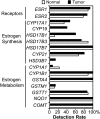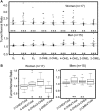Estrogen metabolism in the human lung: impact of tumorigenesis, smoke, sex and race/ethnicity
- PMID: 29290988
- PMCID: PMC5739773
- DOI: 10.18632/oncotarget.22269
Estrogen metabolism in the human lung: impact of tumorigenesis, smoke, sex and race/ethnicity
Abstract
Previous data from this group demonstrate that the murine lung metabolizes estrogen. Production of the putative carcinogen 4-hydroxyestrogen (4-OHE) is elevated within the lungs of female vs. male mice and accelerated by tobacco smoke. The goal of this study was to determine if the human lung metabolizes estrogen and evaluate the impact of tumor formation, smoke, sex and race/ethnicity on metabolism. Urine and lung tissue (normal, tumor) were obtained from 49 non-small cell lung cancer patients. Healthy postmenopausal Caucasian (n = 19) and Chinese (n = 20) American women (never-smokers) donated urine. Quantitative RT-PCR analyses indicate that multiple estrogen synthesis and metabolism genes are expressed in human bronchoalveolar cells. Estrogen and its metabolites were measured in lung tissue and urine using liquid chromatography/tandem mass spectrometry. Wilcoxon rank tests were used for statistical comparisons. E1, E2, E3 and estrogen metabolites 2-OHE1, 2-OHE2, 4-OHE1, 4-OHE2, 2-OME1 and 2-OME2 were detected at higher levels in tumor vs. adjacent normal tissue and in women vs. men (P < 0.05). The proportion of 4-OHEs was higher in tumors than in normal lung tissue (P < 0.05), and elevated in normal tissue from current- vs. never-smoking women (P = 0.006); similar trends were observed in urine. The proportion of 4-OHEs in the urine of postmenopausal Chinese American women was 1.8-fold higher than that of Caucasian women (P = 0.015). These data indicate that estrogen metabolites are present in the human lung. A shift towards 4-hydroxylation during lung tumorigenesis may contribute to the risk conferred by smoking, sex or race/ethnicity.
Keywords: 4-hydroxy estrogen; estrogen metabolism; never-smoking Chinese women; non-small cell lung cancer; tobacco smoke.
Conflict of interest statement
CONFLICTS OF INTEREST The authors have no conflicts of interest to disclose.
Figures




References
-
- Parkin DM, Bray F, Ferlay J, Pisani P. Global cancer statistics, 2002. CA Cancer J Clin. 2005;55:74–108. https://doi.org/55/2/74. - PubMed
-
- Sun S, Schiller JH, Gazdar AF. Lung cancer in never smokers--a different disease. Nat Rev Cancer. 2007;7:778–90. https://doi.org/10.1038/nrc2190. - DOI - PubMed
-
- Epplein M, Schwartz SM, Potter JD, Weiss NS. Smoking-adjusted lung cancer incidence among Asian-Americans (United States) Cancer Causes Control. 2005;16:1085–90. https://doi.org/10.1007/s10552-005-0330-6. - DOI - PubMed
-
- Siegfried JM, Stabile LP. Estrongenic steroid hormones in lung cancer. Semin Oncol. 2014;41:5–16. https://doi.org/10.1053/j.seminoncol.2013.12.009. - DOI - PMC - PubMed
-
- Tsuchiya Y, Nakajima M, Yokoi T. Cytochrome P450-mediated metabolism of estrogens and its regulation in human. Cancer Lett. 2005;227:115–24. https://doi.org/10.1016/j.canlet.2004.10.007. - DOI - PubMed
Grants and funding
LinkOut - more resources
Full Text Sources
Other Literature Sources

